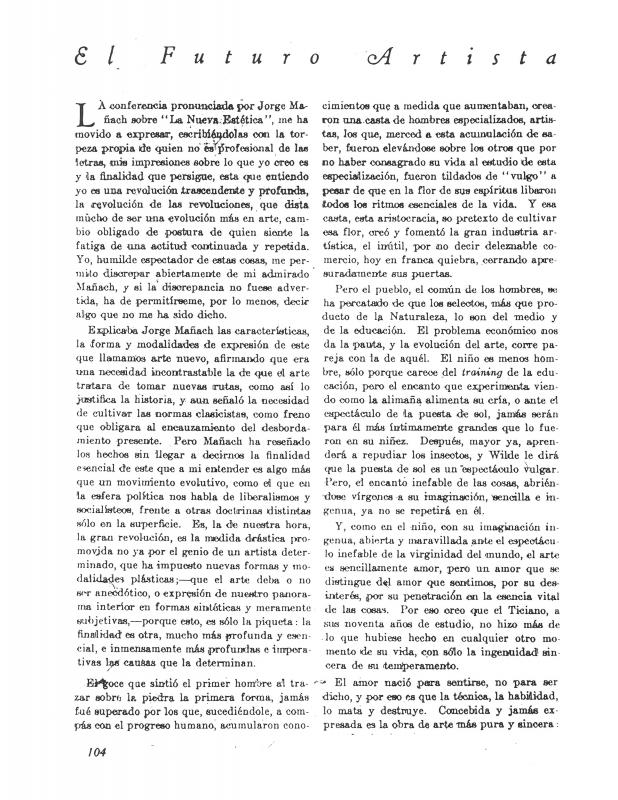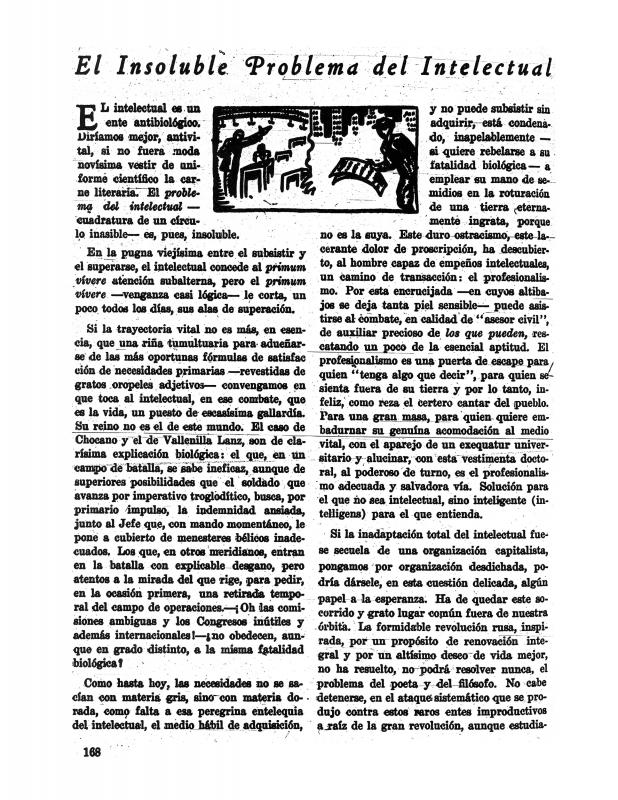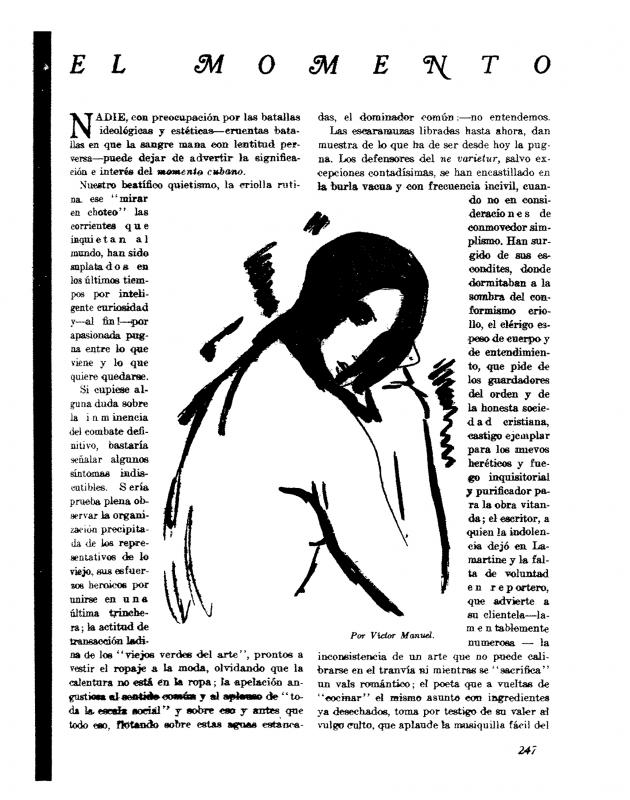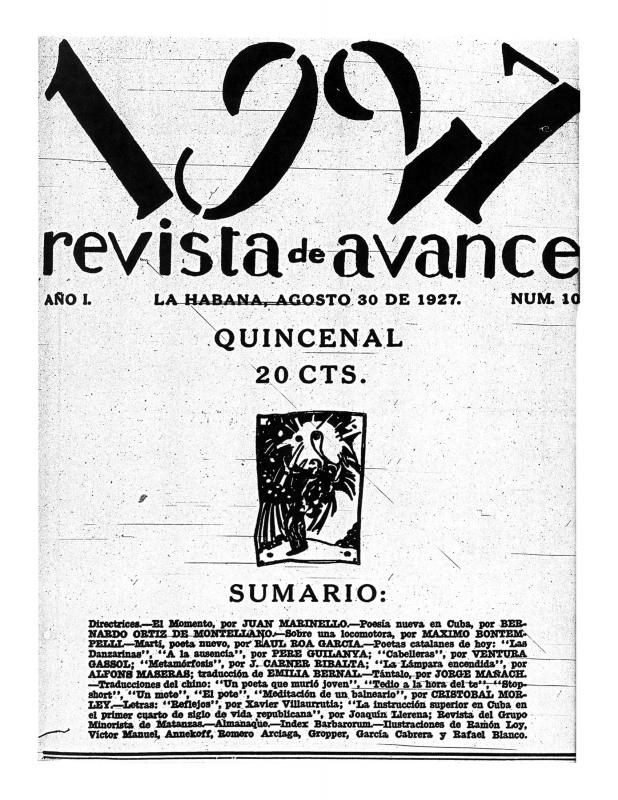1927 Revista de avance was a cultural journal established in Havana for the purpose of promoting “new” art and debating the most recent trends in European art and literature. The editorial team of 1927 Revista de avance, better known as Los Cinco, comprised the distinguished Cuban intellectuals and essay writers Alejo Carpentier (1904–80), Martí Casanovas (1894–1966), Francisco Ichaso (1901–62), Jorge Mañach (1898–1961), and Juan Marinello (1898–1977). By 1927, these individuals had already been working as journalists also involved in political activities, involvements that went back to the early 1920s in Cuba. They had contributed to previous publications such as Social, which was both a precursor to avance and an organ for disseminating the political, aesthetic and cultural concerns of young intellectuals. In addition, Los Cinco had been members of the Grupo Minorista. Founded in 1923, this group could be characterized by its heterogeneity and commitment to the political problems troubling the island. The group was made up of writers, artists, historians, and art critics, as well as intellectuals with law and political science degrees. Some of the issues raised in these circles arose from the political positions of their members, especially those who voiced their vehement opposition to annexation by the United States. “Al levar el ancla” reflects both the literary style of José Martí (1853–95) and his humanistic and critical thinking. Mañach, who would later write on the life of the Cuban poet, was already showing his affinity with the political ideas of “El Apóstol” when he published the manifesto of the Grupo Minorista in 1926 to denounce US intervention in Nicaragua. This brief inaugural article followed the lead of manifestos drafted by artist and intellectual groups starting in the mid-nineteenth century in Europe and in Latin America. On the one hand, European declarations were questioning the values of the bourgeois class. On the other, Latin American manifestos were harbingers of an intellectual culture marked by the social changes and transformations that followed upon struggles for independence and the transition toward being republics. Such concerns were reflected in Latin American literary and artistic spheres, for which the press served as the main spokesman. The aesthetic alliances between literature and art and the urgency of embarking toward new critical horizons was one of the basic characteristics of publications of this type. The sense of renewal with which Los Cinco launched Revista de avance did not necessarily mean a break with the past, but instead it was a critical approach to it. The launch of the journal arose from the ideals fomented by the fervent nationalism underlying thoughts about Cuban independence. It was precisely in avance where writers began to formulate important debates about Cuban identity based on the concept of a nation renewed, understood as a complex sociocultural ensemble. They also addressed the problem of one Latin America as a continent unified by its historical past while simultaneously proposing a look at its diverse nature. Martí himself had already introduced these ideas, which gained greater strength in the cultural theories of Fernando Ortiz (1881–1969), who was a contributor to avance. Of course, these ideas were already starting to appear in the work of artists and writers throughout Latin America. Although it had only five editors, Revista de avance gathered contributions from distinguished artists and writers in Latin America and Europe. [For more information on contributors to Revista de avance, see in the ICAA digital archive “Índice del Tomo I (Números 1 al 12 inclusive)” (doc. no. 1300106)]. [For other essays and texts published in Revista de avance, see the following: by Martí Casanovas “Almanaque” (doc. no. 1299709), “Almanaque: Exposición Gattorno” (doc. no. 1298711), “El capitalismo y la inteligencia” (doc. no. 1299384), “Nuevos Rumbos: La exposición de 1927” (doc. no. 1280155), and “Pierre Flouquet” (doc. no. 1299881); “[El arte nuestro debe ser instintiva o intuitivamente americano...],” by Víctor Andrés Belaúnde (doc. no. 832310); “[Basta con que revele una honda...],” by Carlos Préndez Saldías (doc. no. 832258); “Causerie sobre el Salón de Bellas Artes,” by Adia M. Yunkers (doc. no. 1298799); “[Creo que el artista americano...],” by Ildefonso Pereda Valdés (doc. no. 832328); “Dibujos escolares” (anonymous) (doc. no. 1299805); “Diego Rivera,” by Alejo Carpentier (doc. no. 1299962); “Eduardo Abela: pintor cubano,” by Adolfo Zamora (doc. no. 1280283); “El futuro artista,” by Eduardo Abela (doc. no. 1299789); by Juan Marinello “El insoluble problema del intelectual” (doc. no. 1299897), and “El momento” (doc. no. 1125671); “El prejuicio en el ritmo intelectual de las épocas,” by Francisco Ichaso (doc. no. 1299741); “El problema internacional de Centro América y Cuba,” by Fernando de los Ríos (doc. no. 1300090); “La cuestión del negro” (anonymous) (doc. no. 1280299); “La lección de Juan Gris,” by Juan Gris (doc. no. 1299946); “Marrozzini y la mediocridad: notas sobre declaraciones de Luigi Marrozzini,” by Lorenzo Homar (doc. no. 861634); “Martí: Poeta Nuevo,” by Raúl Roa García (doc. no. 1300003); “Nacionalismo y Costumbrismo,” by Severo García Pérez (doc. no. 1300058); “Nacionalismos en América,” by Eugenio d’Ors (doc. no. 1299757); “Nota de los 5—2,” by Jorge Mañach et al. (doc. no. 1299930); “Programa de criolledad,” by Félix Lizaso (doc. no. 1125414); and “Vértice del gusto nuevo,” by Jorge Mañach (doc. no. 832383)].













